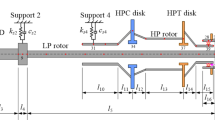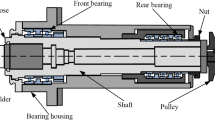Abstract
This paper presents a method to analyze the free vibration of a rotating disk–spindle system in a HDD with hydrodynamic bearings (HDBs) considering the flexibility of a complicated base structure by using finite element method. Finite element equations of each component of a HDD spindle system from the spinning flexible disk to the flexible base plate are consistently derived by satisfying the geometric compatibility in the internal boundary between each component. The rigid link constraints are also imposed at the interface area between the sleeve and hydrodynamic bearings to describe the physical motion at this interface. A global matrix equation obtained by assembling the finite element equations of each substructure is transformed to a state-space matrix-vector equation, and both damped natural frequencies and modal damping ratios are calculated by solving the associated eigenvalue problem by using the restarted Arnoldi iteration method. The validity of the proposed method is verified by comparing the calculated damped natural frequencies and modes with the experimental results. This research also shows that the supporting structure which includes the stator, housing and base plate plays an important role in determining the natural frequencies and mode shapes of a HDD spindle system













Similar content being viewed by others
References
Cook RD, Malkus DS, Plesha ME (1989) Concepts and applications of finite element analysis, 3rd edn. Wiley, New York
Hinton E, Owen DRJ (1977) Finite element programming. Academic, London
Hughes JR (1987) The finite element method. Prentice-Hall, Englewood Cliffs, NJ
Jang GH, Kim JY (1999) Calculation of dynamic coefficients in a hydrodynamic bearing considering five degrees of freedom for a general rotor-bearing system. ASME J Tribol 121(3):499–505
Jintanawan T, Shen IY, Ku C-PR (1999) Free and forced vibrations of a rotating disk pack and spindle motor system with hydrodynamic bearings. J Inf Storage Process Syst 1:45–58
Lehoucq RB, Sorensen DC (1996) Deflation techniques for an implicitly restarted Arnoldi iteration. SIAM J Matrix Anal Appl 17(4):789–821
Nelson HD (1980) Finite rotating shaft element using Timoshenko beam theory. J Mech Des 102:793–803
Pawlak TP, Yunus SM, Cook RD (1991) Solid elements with rotational degrees of freedom: Part II—Tetrahedron elements. Int J Numer Methods Eng 31:593–610
Petyt M (1990) Introduction to finite element vibration analysis. Cambridge University Press, Cambridge
Reddy JN (1993) An introduction to the finite element method, 2nd edn. McGraw-Hill, New York
Saad Y (1995) Iterative methods for sparse linear systems. PWS Publishing Company, Boston
Tseng CW, Shen JY, Shen IY (2003) Vibration of rotating-shaft HDD spindle motors with flexible stationary parts. IEEE Trans Magn 39:794–799
Ugural AC, Fenster SK (1981) Advanced strength and applied elasticity. Elsevier, Amsterdam
Zang Y, Hatch MR (1996) On the whirl dynamics of hydrodynamic bearing spindle in information storage systems. Int Symp Inf Storage Process Syst 2:73–84
Author information
Authors and Affiliations
Corresponding author
Rights and permissions
About this article
Cite this article
Jang, G.H., Han, J.H. & Seo, C.H. Finite element modal analysis of a rotating disk–spindle system in a HDD with hydrodynamic bearings considering the flexibility of a complicated supporting structure. Microsyst Technol 11, 488–498 (2005). https://doi.org/10.1007/s00542-005-0597-2
Received:
Accepted:
Published:
Issue Date:
DOI: https://doi.org/10.1007/s00542-005-0597-2




